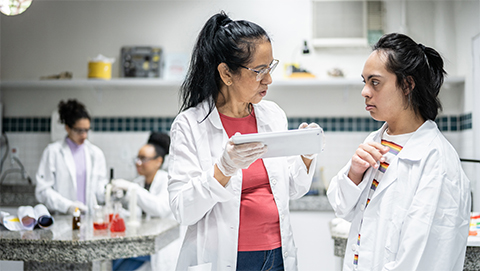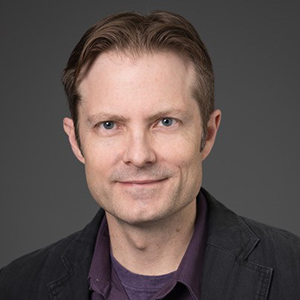Beyond the science: What else should a PI teach a rotating graduate student?
At most universities, graduate students rotate through multiple laboratories before deciding which is best suited for their studies. During these rotations, which span an average of eight weeks, students learn the fundamentals central to the laboratory’s research, receive training in associated experimental techniques and get a sense of the laboratory’s culture.

Over the past 20 years, I’ve fielded many questions from rotating students who are curious about aspects of the scientific enterprise that usually are not taught in the classroom. These questions remind me of how little I understood about research funding, effective science communication and career options when I started graduate school. It occurred to me that a rotation period is a great opportunity to introduce students to these practical topics. Setting aside 30 minutes a week to review these subjects with your student helps round out the rotation experience.
Here are the topics I address in my weekly “Beyond the Science” meetings with rotation students.
Week 1. What can you do with a Ph.D.?
Many students enroll in a Ph.D. program with plans to stay in academia, but I make a point of telling them about other career options they could consider. While most students are knowledgeable about the biotech and pharmaceutical industries, they are less aware of positions in government, law, nonprofit research groups, technical writing, or science communication and outreach.
While obtaining a Ph.D., a successful student develops a set of transferable skills that are attractive to a wide variety of employers in other occupations, including those outside of scientific research. These skills include critical thinking, project management, communication, organization, and the ability to work either independently or as a member of a team. This discussion can show the student the many different doors a Ph.D. allows them to open.
Week 2. How to stay on top of the literature.
Many students know that the search for published research papers begins with PubMed, but they are less familiar with the various ways the search engine can be interrogated by combing keywords or searching for author(s). Lesser-known sites such as Google Scholar and ResearchGate are also good sources for finding published research articles or following authors of interest. In addition to these sources of peer-reviewed research, it is important to teach students about preprint repositories such as bioRxiv and medRxiv.
Staying informed is key to success in science, so I teach students how to set up alert services through PubMed or a third-party platform like PubCrawler. Since preprints are not indexed in PubMed, independent alerts can be set up through these sites. Some investigators still rely on emailed tables of contents from their favorite journals, which are set up easily through the journal websites. Finally, social media, especially Twitter, is a useful way to stay informed about the latest research or publications (more on this in Week 5).
Week 3. Who funds scientific research?
This lesson covers the variety of internal (institutional) and external funding available for scientific research, how to identify an appropriate funding agency and mechanism, and how to apply (grant writing is reviewed during Week 6). In addition to highlighting the dominant federal sources of funding for basic research such as the National Institutes of Health and the National Science Foundation, I tell students that other government agencies offer research grants, such as the U.S. Department of Agriculture and the Department of Defense.
Outside of government agencies, I point out the many nonprofit organizations and foundations that offer research grant opportunities, such as the American Heart Association, the PhRMA Foundation, or the Bill & Melinda Gates Foundation. The list of opportunities will differ depending on the type of research conducted by the laboratory. Because federal funding is so competitive, researchers need to know about these additional options.
More germane to a graduate student, I also review training grants and travel grants for which they may be eligible. I encourage students to sign up for email notifications from relevant agencies so they can keep a finger on the pulse of research trends and stay vigilant for predoctoral fellowship opportunities.
Week 4. The importance of scientific conferences.
In this lesson, I educate students about the types of scientific meetings they can attend and why it is important to do so. Many students never have been to a conference, so I like to start with the basics, including a discussion on the sizes and scopes of various scientific meetings, their links to scientific societies (if applicable), and how attendees often can present a talk or poster. I emphasize that conferences are critical for staying apprised of recent developments in the field, networking with colleagues and gaining valuable presentation skills.
To help students learn how to prepare compelling abstracts for conferences, I refer them to “How to write a killer abstract in 10 sentences.”
Week 5. Science and social media.
Most students already are engaged with social media, but they may not be using it as a research or career development tool. I show them that Twitter is used by journals, funding agencies, science news sites and their fellow scientists. Twitter can help students make connections, establish research collaborations, follow conference proceedings or seek help with experiments from the scientific hivemind. It is also useful to establish a profile on more career-oriented social media sites such as LinkedIn.
Social media provide students with a way to build their scientist brand, which can help plug them into a network of like-minded researchers and catalyze their career development.
Week 6. Planning and writing grants and papers.
It is never too early to contemplate how a research project might look in grant or paper form. While science remains unpredictable, it is useful to pose a single, focused question at the outset and design studies to address the hypothesis. I advocate that graduate students avoid thesis projects that are too exploratory and risky in favor of more defined projects that will yield a publishable result regardless of the outcome.
My strategy for grant and paper planning resembles the storyboarding approach that filmmakers use. But instead of putting scenes in order to make up a movie, I put the paper’s envisioned figures in order. With graduate students, I also review the different types of journals, what impact factors mean, how peer review works and the concept behind preprints.
To further guide the discussion on grant writing, I refer to my article, “Grant-writing tips for beginners.”
Week 7. Preparing a scientific talk.
I’ve developed a method of presenting science modeled after a mystery dinner theater. Almost any scientific question can be framed as an intriguing mystery (the appetizer), which is addressed by gathering clues generated during experiments (the main course). Finally, the dessert course should be a satisfying conclusion that reveals how the clues helped solve the mystery.
In addition to sharing this method, I encourage students to attend as many research seminars as they can, not only to expand their research horizons but also to study different speaker and presentation styles. I encourage students to take notice of what makes a seminar lousy or exceptional so they can improve their own presentations.
Week 8. Evaluation of student rotation presentation.
Students end their rotation in our laboratory by giving a short (15-20 minute) synopsis of their project. This presentation follows the model they learned in Week 7, in which students describe the nature and significance of the research question, what experiments were attempted to address the question, what the findings revealed and how the project should move forward.
The final lesson is dedicated to critiquing this presentation, reviewing the strengths as well as the areas that could use improvement.
If you run a lab, I hope the ideas in this article inspire you to enrich your students’ rotation experience. And if you’re a graduate student, I hope you seek lessons like these from the researchers you meet and work with. There is so much to teach and learn besides experimental design and troubleshooting.
Enjoy reading ASBMB Today?
Become a member to receive the print edition four times a year and the digital edition monthly.
Learn moreFeatured jobs
from the ASBMB career center
Get the latest from ASBMB Today
Enter your email address, and we’ll send you a weekly email with recent articles, interviews and more.
Latest in Careers
Careers highlights or most popular articles

Mapping proteins, one side chain at a time
Roland Dunbrack Jr. will receive the ASBMB DeLano Award for Computational Biosciences at the ASBMB Annual Meeting, March 7–10, just outside of Washington, D.C.

Exploring the link between lipids and longevity
Meng Wang will present her work on metabolism and aging at the ASBMB Annual Meeting, March 7-10, just outside of Washington, D.C.

Upcoming opportunities
Calling all biochemistry and molecular biology educators! Share your teaching experiences and insights in ASBMB Today’s essay series. Submit your essay or pitch by Jan. 15, 2026.

Defining a ‘crucial gatekeeper’ of lipid metabolism
George Carman receives the Herbert Tabor Research Award at the ASBMB Annual Meeting, March 7–10, just outside of Washington, D.C.

Building the blueprint to block HIV
Wesley Sundquist will present his work on the HIV capsid and revolutionary drug, Lenacapavir, at the ASBMB Annual Meeting, March 7–10, in Maryland.

Upcoming opportunities
Present your research alongside other outstanding scientists. The #ASBMB26 late-breaking abstract deadline is Jan. 15.

